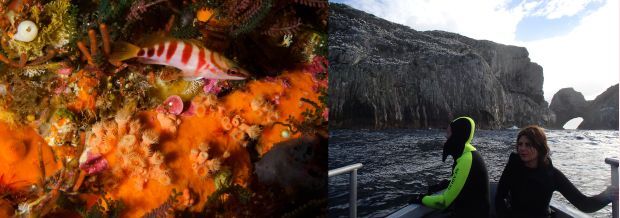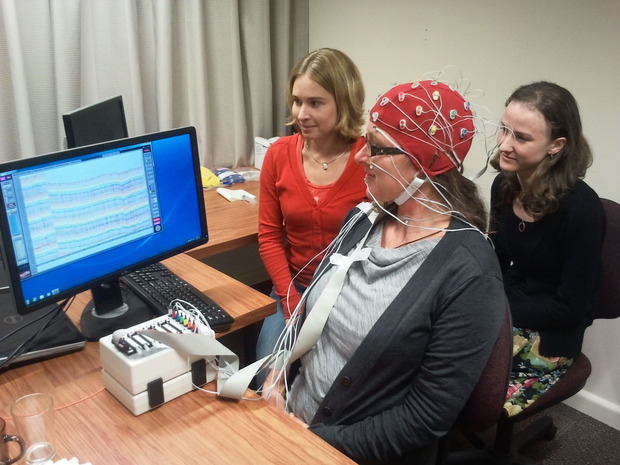Our Changing World for Thursday 13 June 2013
Three Kings Islands Marine Expedition

Expedition vessel RV Braveheart, and the Princes Islands group (images: A. Ballance)
The Three Kings Islands lie just 55 kilometres north of Cape Reinga, but as a team of marine biologists discovered during a two-week expedition in April 2013 these storm-battered islands are a world of their own, with an underwater world that is distinctly different from the nearby mainland.

Wendy Nelson sorting seaweeds, butterfly perch and Johnson's sargassunm, and Severine Hannam sorting inverebrate samples after a dive (topside images: A. Ballance & underwater image: M. Francis)
Alison Ballance joined the Three Kings Islands Marine Expedition on board RV Braveheart, skippered by Matt Jolly, as a team of 14 experts and photographers sampled the marine algae, fish and invertebrates that manage to make these wave-washed shores their home. The discoveries included six new records of fish for the island group, an unusual stalked jellyfish and numerous types of seaweed, many of them rare and undescribed.
Expedition leader was Tom Trnski from Auckland Museum – he's Head of Natural Sciences and a fish biologist with a special interest in larval fish, and he also led the Museum’s 2011 Kermadec Islands Biodiscovery Expedition. Also from Auckland Museum was collection technician Ged Wiren and natural sciences collection manager Severine Hannam.

Half-banded perch amongst sponges and ascidians, and Malcolm Francis and Roberta D'Archino next to archway and cliffs in the Princes Islands - the white 'dusting' on top of the island is a large colony of gannets (underwater image: M. Francis & topside image: A. Ballance)
Roberta D’Archino from NIWA and Wendy Nelson from the University of Auckland and NIWA are marine algae (seaweed) experts. Malcolm Francis is a fish biologist at NIWA, and Kareen Schnabel looks after NIWA’s marine invertebrate collection. Vincent Zintzen is a researcher and Jeremy Barker is a research technician, both from Te Papa, and Libby Liggins is a PhD student at the University of Queensland.

Juvenile piper collected at night are a new record for the Three Kings Islands, and Vincent Zintzen and Kareen Schnabel bait a trap with catfood to attract hagfish and isopods (images: A. Ballance)
Brain Function and Stuttering

Catherine Theys, left, and Annalise Fletcher watch as Veronika Meduna prepares for an experiment designed to analyse brain activity during the moments just before speaking (image: V Meduna)
Developmental stuttering affects one child in 20, and for some the problem persists into adulthood. At this stage, there is no cure, or even permanent treatment, for the more than 30,000 adult stutterers in New Zealand, largely because the cause of stuttering remains unclear.
Stuttering has long been thought of as a mostly psychological problem. However, brain imaging studies have linked the condition with differences in brain processing, including variations in brain areas that control motor and auditory functions. Most such studies have used imaging techniques such as Positron Emission Tomography and Magnetic Resonance Imaging (MRI), which provide good spatial resolution of what happens where in the brain, but don't deliver sufficient information about the sequence of events just before a person prepares to speak. Catherine Theys, at the University of Canterbury's Institute of Language, Brain and Behaviour, is using a combination of MRI and electroencephalography (EEG) techniques to elucidate the 'when' and 'where' of stuttering, with the aim of entangling whether the observed brain differences are in fact part of the cause of stuttering or whether they have developed as a consequence of having to compensate for dysfluent speech. She also hopes to develop a neurocomputational model of stuttering, focusing in particular on the planing phase of speech production.